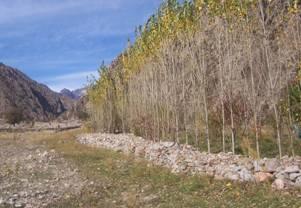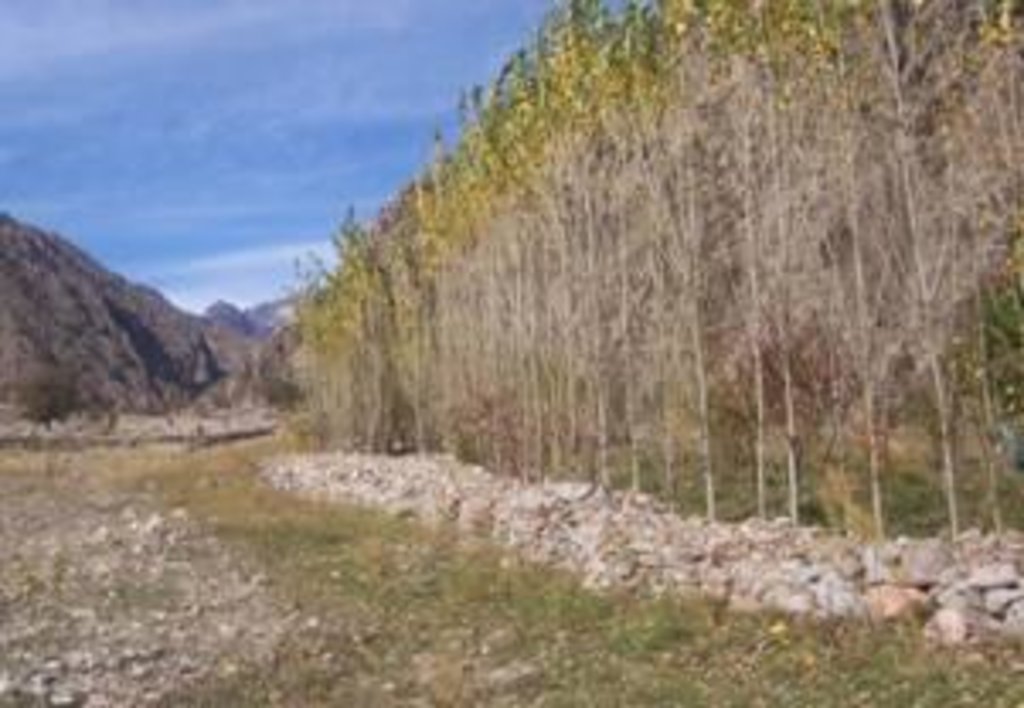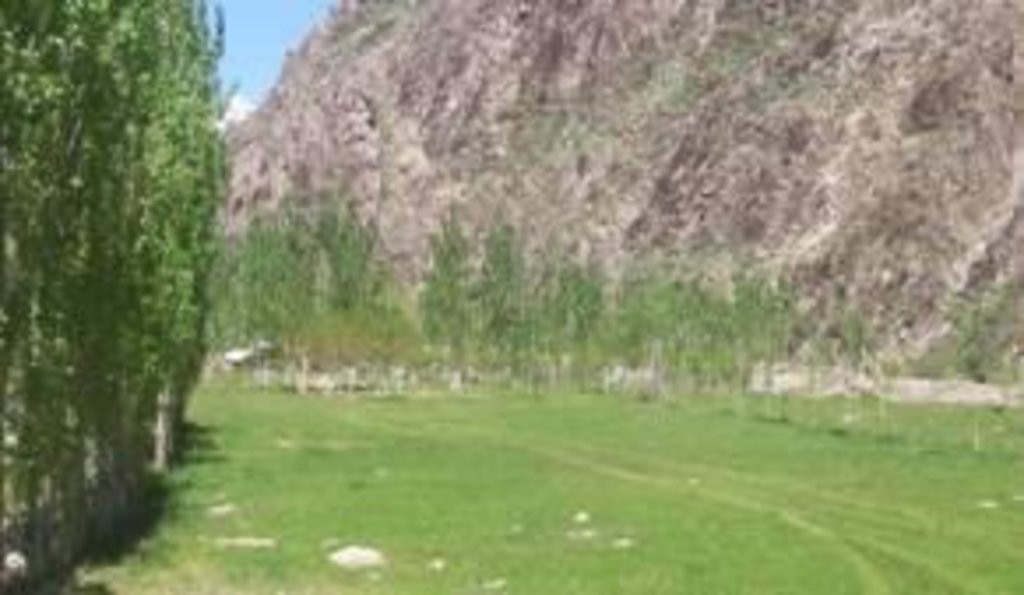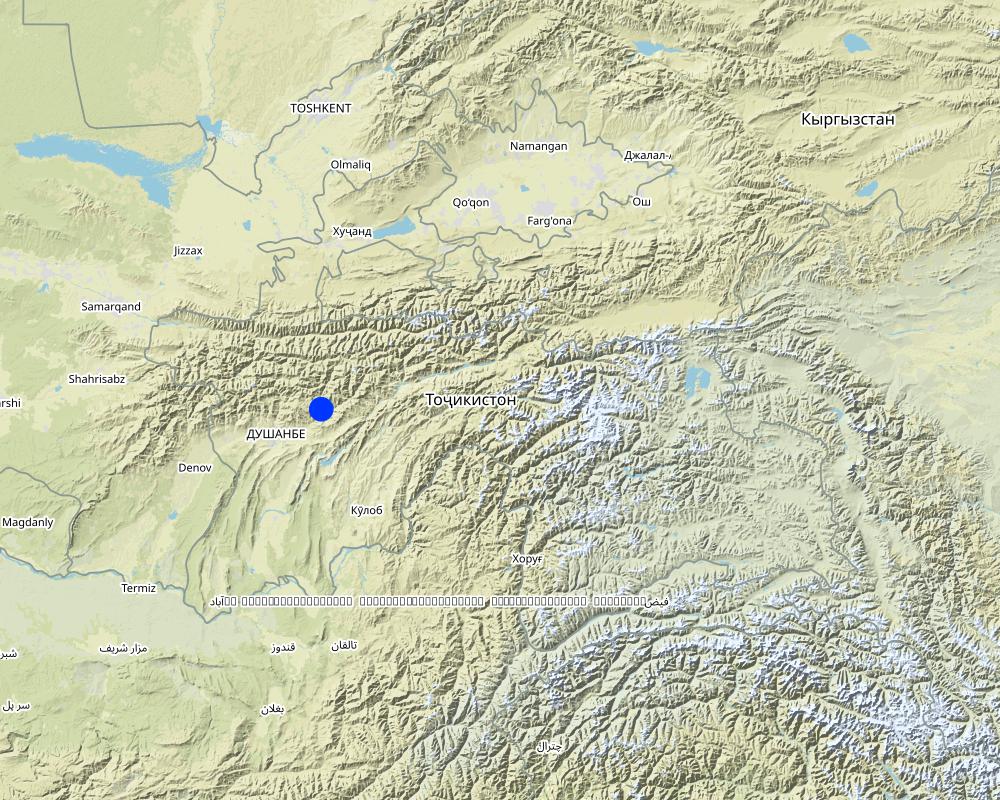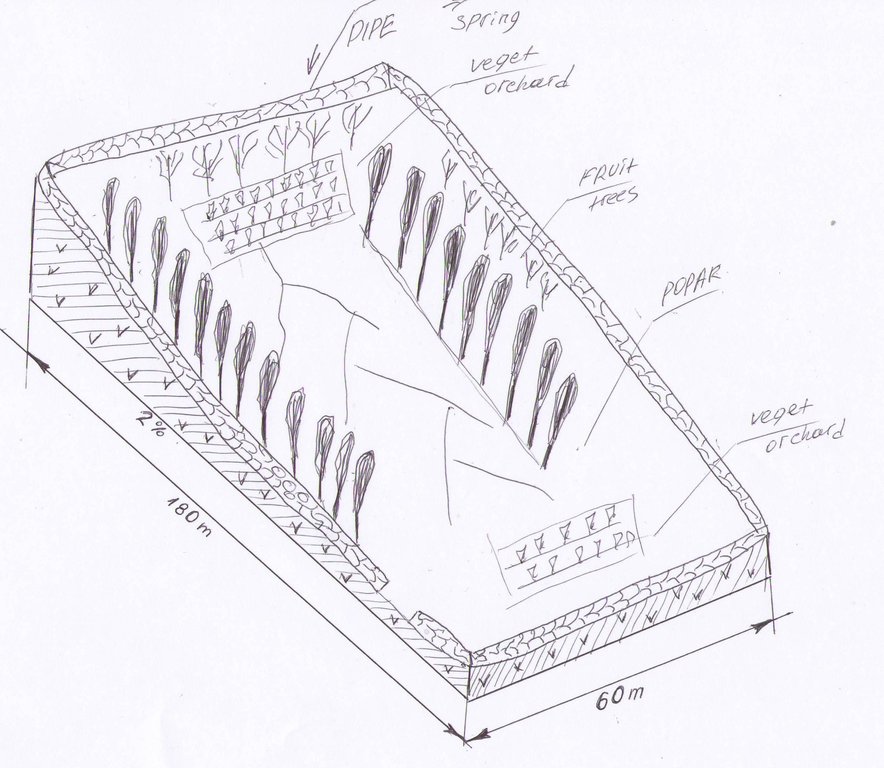Integrated stone wall and poplar tree perimeter fencing [Tadjikistan]
- Création :
- Mise à jour :
- Compilateur : Habib Kamolidinov
- Rédacteur : –
- Examinateurs : Alexandra Gavilano, David Streiff, Joana Eichenberger
technologies_1107 - Tadjikistan
- Résumé complet en PDF
- Résumé complet en PDF pour impression
- Résumé complet dans le navigateur
- Résumé complet (non formaté)
- Integrated stone wall and poplar tree perimeter fencing: 21 mars 2017 (inactive)
- Integrated stone wall and poplar tree perimeter fencing: 23 juillet 2017 (inactive)
- Integrated stone wall and poplar tree perimeter fencing: 14 août 2019 (inactive)
- Integrated stone wall and poplar tree perimeter fencing: 2 novembre 2021 (public)
Voir les sections
Développer tout Réduire tout1. Informations générales
1.2 Coordonnées des personnes-ressources et des institutions impliquées dans l'évaluation et la documentation de la Technologie
Spécialiste GDT:
Nom du projet qui a facilité la documentation/ l'évaluation de la Technologie (si pertinent)
Pilot Program for Climate Resilience, Tajikistan (WB / PPCR)Nom du ou des institutions qui ont facilité la documentation/ l'évaluation de la Technologie (si pertinent)
GITEC/ADB/DMC Rural Development Project Land Management Institute - Tadjikistan1.3 Conditions relatives à l'utilisation par WOCAT des données documentées
Le compilateur et la(les) personne(s) ressource(s) acceptent les conditions relatives à l'utilisation par WOCAT des données documentées:
Oui
2. Description de la Technologie de GDT
2.1 Courte description de la Technologie
Définition de la Technologie:
Stones cleared from land within a narrow valley floor where flat land is at a premium, was used to construct a perimeter stone wall which was subsequently supplemented with a row of poplar tree to protect an agro-forestry area with small scale supplementary irrigation.
2.2 Description détaillée de la Technologie
Description:
The area in question is a very narrow, flat valley floor, 95% of which was covered in stones and boulders, and devoid of vegetation, both grass and trees/shrubs. The stones in the area were cleared and used to build a protecting, perimeter wall (approx. 1.5 m high). This was then supplemented by an inner row of fast growing poplar trees. The stone clearing has resulted in deeper soil within the protected area that has led to far greater vegetation coverage, such as grass (that can be cut and used as fodder), forest and orchard trees and vegetable gardens. Irrigation was provided to the area by a small diameter poly pipe from a permanent spring. The area is now being extended to almost double the size of the initial walled agro-forest area.
Purpose of the Technology: The farmer’s primary aim, in initiating and continuing this SLM approach, was to “leave a legacy of improved land” for future generations, recognising how little flat and potentially productive land there is in this high, narrow valley location. Clearing the land of stones and building a walled enclosure that was irrigated greatly assured the quantity and quality of fodder for his animals, as they remain fenced in beside his village home almost all year. Fruit and vegetable production was also greatly improved.
Establishment / maintenance activities and inputs: The family commenced stone clearing and wall construction in 2005. The next task was tree planting; poplar trees were planted around the wall's perimeter. The irrigation source was tapped into using a poly pipe. The vegetable gardens are seasonal and their plants change with the seasons and the family’s needs. Stone removal continues even now, to improve the soil in the walled area. The farmer hopes to extend the walled area in the future.
Natural / human environment: Before the family began clearing stones and building the wall, this land had almost zero productivity. This area has a shortage of cultivated land and with increases in popluation and continued food insecurity, cultivated land is at a premium.
2.3 Photos de la Technologie
2.5 Pays/ région/ lieux où la Technologie a été appliquée et qui sont couverts par cette évaluation
Pays:
Tadjikistan
Région/ Etat/ Province:
Central District of Tajikistan
Autres spécifications du lieu:
Kushon village, Romit Jamoat, Vahdat
Spécifiez la diffusion de la Technologie:
- répartie uniformément sur une zone
S'il n'existe pas d'informations exactes sur la superficie, indiquez les limites approximatives de la zone couverte:
- < 0,1 km2 (10 ha)
Commentaires:
A small area was all that the family could manage as there was an initial large workload, clearing stones and fence building, etc
Map
×2.6 Date de mise en œuvre de la Technologie
Si l'année précise est inconnue, indiquez la date approximative: :
- il y a moins de 10 ans (récemment)
2.7 Introduction de la Technologie
Spécifiez comment la Technologie a été introduite: :
- grâce à l'innovation d'exploitants des terres
Commentaires (type de projet, etc.) :
The initiative began in 2005 and has been ongoing ever since, it continues to improve, at least up to 2010 when reviewed.
3. Classification de la Technologie de GDT
3.1 Principal(aux) objectif(s) de la Technologie
- increase size of agrictultural land
3.2 Type(s) actuel(s) d'utilisation des terres, là où la Technologie est appliquée
Les divers types d'utilisation des terres au sein du même unité de terrain: :
Oui
Précisez l'utilisation mixte des terres (cultures/ pâturages/ arbres):
- Agroforesterie

Terres cultivées
- Cultures annuelles
- Cultures pérennes (non ligneuses)
- Plantations d’arbres ou de buissons
Plantations d'arbres et d'arbustes - Précisez les cultures:
- fruits à noyaux (pêche, abricot, cerise, prune)
- fruits à pépins (pommes, poires, coings, etc.)
Nombre de période de croissance par an: :
- 1
Précisez:
Longest growing period in days: 180Longest growing period from month to month: April to September

Pâturages
Type d'animal:
- bétail - laitier
- ovins

Forêts/ bois
Produits et services:
- Bois de chauffage
- Fruits et noix
- Autres produits forestiers
Commentaires:
Major land use problems (compiler’s opinion): This area is strongly dependent on the extremely limited flat, valley bottom land for the production of pasture, 'cut and carry' fodder, orchards and vegetable production. 95% of this land is covered in stones that require removal before any productive capacity can be achieved. Even when cleared of stones the soil is still very shallow (< 20cm) and requires irrigation to ensure plants survive the hot summer months
Major land use problems (land users’ perception): Same – the above words were used by him in the on-farm interview
Cut-and-carry/ zero grazing: sheep/cattle
Plantation forestry: The Poplar trees they planted are pruned and thinned for firewood and construction materials
Other type of forest: orchard species: Apple, Apricot, Cherry
Forest products and services: timber, fuelwood, fruits and nuts
Future (final) land use (after implementation of SLM Technology): Grazing land: Gi: Intensive grazing/ fodder production
3.3 Est-ce que l’utilisation des terres a changé en raison de la mise en œuvre de la Technologie ?
Est-ce que l’utilisation des terres a changé en raison de la mise en œuvre de la Technologie ?
- Oui (Veuillez remplir les questions ci-après au regard de l’utilisation des terres avant la mise en œuvre de la Technologie)

Pâturages

Autre
Précisez:
wastelands, deserts, glaciers, swamps, recreation areas, etc
3.4 Approvisionnement en eau
Approvisionnement en eau des terres sur lesquelles est appliquée la Technologie:
- mixte: pluvial-irrigué
3.5 Groupe de GDT auquel appartient la Technologie
- agroforesterie
- Amélioration de la couverture végétale/ du sol
3.6 Mesures de GDT constituant la Technologie

pratiques agronomiques
- A1: Couverture végétale/ du sol

pratiques végétales
- V1: Couverture d’arbres et d’arbustes
- V2: Herbes et plantes herbacées pérennes

structures physiques
- S6: Murs, barrières, palissades, clôtures

modes de gestion
- M1: Changement du type d’utilisation des terres
- M2: Changement du niveau de gestion / d'intensification
- M3: Disposition/plan en fonction de l'environnement naturel et humain
- M4: Changement majeur dans le calendrier des activités
- M5: Contrôle/ changement de la composition des espèces
Commentaires:
Main measures: agronomic measures, vegetative measures, structural measures, management measures
Type of agronomic measures: better crop cover, mixed cropping / intercropping, cover cropping, retaining more vegetation cover, furrows (drainage, irrigation)
Type of vegetative measures: aligned: -along boundary, in blocks
3.7 Principaux types de dégradation des terres traités par la Technologie

érosion hydrique des sols
- Wt: perte de la couche superficielle des sols (couche arable)/ érosion de surface

dégradation biologique
- Bc: réduction de la couverture végétale
- Bh: perte d’habitats
- Bq: baisse de la quantité/ biomasse
- Bl: perte de la vie des sols
Commentaires:
Main type of degradation addressed: Wt: loss of topsoil / surface erosion, Bc: reduction of vegetation cover, Bh: loss of habitats, Bq: quantity / biomass decline, Bl: loss of soil life
Secondary causes of degradation: land tenure (The lack of good quality available land puts pressure on the lower grade land.), poverty / wealth (People still need land to harvest to survive.)
3.8 Prévention, réduction de la dégradation ou réhabilitation des terres dégradées
Spécifiez l'objectif de la Technologie au regard de la dégradation des terres:
- restaurer/ réhabiliter des terres sévèrement dégradées
Commentaires:
Secondary goals: prevention of land degradation, mitigation / reduction of land degradation
4. Spécifications techniques, activités, intrants et coûts de mise en œuvre
4.1 Dessin technique de la Technologie
Spécifications techniques (associées au dessin technique):
The drawing shows a 1.5m high stone wall, lined with poplar trees on a gentle slope. The site is located in the valley floor and has access to a naturally occuring spring. The enclosed land is now used mainly for fodder production, intercropped with fruit trees and vegetable patches.
Location: Khatlon province. Kushon village, Romit jamoat, Vahdat raion
Date: 21.04.2011
Technical knowledge required for land users: high (The farmer has a good understanding of farming techniques.)
Main technical functions: improvement of ground cover, improvement of topsoil structure (compaction), increase in organic matter, increase in nutrient availability (supply, recycling,…), increase of infiltration, increase / maintain water stored in soil, increase of biomass (quantity), promotion of vegetation species and varieties (quality, eg palatable fodder)
Secondary technical functions: control of dispersed runoff: impede / retard, reduction of slope angle, reduction of slope length, improvement of subsoil structure (hardpan), stabilisation of soil (eg by tree roots against land slides), increase of groundwater level / recharge of groundwater, reduction in wind speed, spatial arrangement and diversification of land use
Better crop cover
Material/ species: Perennial pasture (grass) for fodder
Quantity/ density: 100 %
Remarks: covers 1.3 ha
Mixed cropping / intercropping
Material/ species: Forest and orchard trees with fodder grasses and vegetable gardens
Quantity/ density: 100
Remarks: dramatically increased
Cover cropping
Material/ species: Perennial grass is the cover crop
Quantity/ density: 100
Remarks: dramatically increased
Retaining more vegetation cover
Material/ species: Land previously bare and stony
Quantity/ density: 100
Remarks: vegetation cover increased
Furrows (drainage, irrigation)
Material/ species: Irrigation via hand cut 20cm cube ditches and poly pipe from nearby spring
Agronomic measure: Stone removal and clearance
Aligned: -along boundary
Vegetative material: T : trees / shrubs
Number of plants per (ha): 1200
Spacing between rows / strips / blocks (m): 1 m
In blocks
Vegetative material: F : fruit trees / shrubs
Number of plants per (ha): 60% cover
Vertical interval between rows / strips / blocks (m): About 0.5 ha planted
Trees/ shrubs species: Poplar trees - planted
Fruit trees / shrubs species: Apple, cherry, apricot - planted
Grass species: Grass - natural
Other species: Vegetable garden - planted
Slope (which determines the spacing indicated above): 0.00%
Wall/ barrier
Vertical interval between structures (m): Wall around area
Height of bunds/banks/others (m): 1.5
Width of bunds/banks/others (m): 0.7
Length of bunds/banks/others (m): 500
Construction material (stone): Stone wall – from stones removed from within area
Lateral gradient along the structure: 3 degrees%
Auteur:
Des Mcgarry, Land Management Institute, Giprozem 15, Dushanbe, Tajikistan
4.2 Informations générales sur le calcul des intrants et des coûts
autre/ monnaie nationale (précisez):
somoni
Indiquez le taux de change des USD en devise locale, le cas échéant (p.ex. 1 USD = 79.9 réal brésilien): 1 USD = :
4,5
Indiquez le coût salarial moyen de la main d'œuvre par jour:
4.50
4.3 Activités de mise en place/ d'établissement
| Activité | Calendrier des activités (saisonnier) | |
|---|---|---|
| 1. | Stone clearing | On initial set up |
| 2. | Wall building | On initial set up |
| 3. | Tree planting | annually |
| 4. | Irrigation pipe | On initial set up |
| 5. | Vegetable garden | annually |
4.4 Coûts et intrants nécessaires à la mise en place
| Spécifiez les intrants | Unité | Quantité | Coûts par unité | Coût total par intrant | % du coût supporté par les exploitants des terres | |
|---|---|---|---|---|---|---|
| Main d'œuvre | Stone clearing | Persons/day | 15,0 | 50,0 | 750,0 | 100,0 |
| Main d'œuvre | Wall building | Persons/day | 15,0 | 50,0 | 750,0 | 100,0 |
| Main d'œuvre | Tree planting | Persons/day | 10,0 | 25,0 | 250,0 | 100,0 |
| Main d'œuvre | Vegetable garden | Persons/day | 20,0 | 15,0 | 300,0 | 100,0 |
| Equipements | Tools | Pieces | 6,0 | 16,66666666 | 100,0 | 100,0 |
| Matériel végétal | Trees | Pieces | 100,0 | 10,0 | 1000,0 | 100,0 |
| Matériel végétal | Plants for vegetable garden | - | 1,0 | 450,0 | 450,0 | 100,0 |
| Matériaux de construction | Irrigation pipe | meter | 700,0 | 3,0 | 2100,0 | 100,0 |
| Matériaux de construction | Wall | meter | 500,0 | 7,0 | 3500,0 | 100,0 |
| Coût total de mise en place de la Technologie | 9200,0 | |||||
| Coût total de mise en place de la Technologie en dollars américains (USD) | 2044,44 | |||||
Commentaires:
Duration of establishment phase: 12 month(s)
4.5 Activités d'entretien/ récurrentes
| Activité | Calendrier/ fréquence | |
|---|---|---|
| 1. | Stone clearing | Annually |
| 2. | Vegetable garden | Annually |
| 3. | Tree planting | Annually |
| 4. | Animal husbandry | Annually |
| 5. | Fertilising and cultivating (garden vegetables) | Annually |
| 6. | Tree planting | Annually |
| 7. | Vegetable planting | Seasonally |
| 8. | random stone removal | Annual |
4.6 Coûts et intrants nécessaires aux activités d'entretien/ récurrentes (par an)
| Spécifiez les intrants | Unité | Quantité | Coûts par unité | Coût total par intrant | % du coût supporté par les exploitants des terres | |
|---|---|---|---|---|---|---|
| Main d'œuvre | Stone clearing | Persons/day | 10,0 | 25,0 | 250,0 | 100,0 |
| Main d'œuvre | Vegetable garden | Persons/day | 50,0 | 25,0 | 1250,0 | 100,0 |
| Main d'œuvre | Tree planting | Persons/day | 20,0 | 15,0 | 300,0 | 100,0 |
| Main d'œuvre | Animal husbandry | Persons/day | 40,0 | 15,0 | 600,0 | 100,0 |
| Autre | Labour: Fertilising and cultivating | Persons/day | 20,0 | 15,0 | 300,0 | 100,0 |
| Autre | Labour: Random stone removal | Persons/day | 10,0 | 15,0 | 150,0 | 100,0 |
| Coût total d'entretien de la Technologie | 2850,0 | |||||
| Coût total d'entretien de la Technologie en dollars américains (USD) | 633,33 | |||||
Commentaires:
Machinery/ tools: All works done manually., all done manually, All work done manually.
Wall – length; all money spent in first 1 or 2 years
Trees – per unit tree; initial start up and annual costs, now ongoing.
Vegetable seeds – per packet, annually
4.7 Facteurs les plus importants affectant les coûts
Décrivez les facteurs les plus importants affectant les coûts :
The human labour costs involving the family were nothing as they willingly gave of their time to clear the land and build the wall, plant trees and create vegetable gardens. The real labour cost were the few days when the farmer paid 3 men to help build the wall.
The cost of the wall cost was also nothing as all materials came from on site.
Trees – there was an initial start up cost and the farmer said he tries to plant at least 20 new trees each year to maintain and enhance productivity
Grasses (fodder) – are self regenerating and local. The farmer has never bought grass seed or used fertiliser on the grass
5. Environnement naturel et humain
5.1 Climat
Précipitations annuelles
- < 250 mm
- 251-500 mm
- 501-750 mm
- 751-1000 mm
- 1001-1500 mm
- 1501-2000 mm
- 2001-3000 mm
- 3001-4000 mm
- > 4000 mm
Spécifications/ commentaires sur les précipitations:
Dominate in Spring (March-May) The period June to September is very hot and dry (almost no rain).
Zone agro-climatique
- semi-aride
Thermal climate class: temperate
5.2 Topographie
Pentes moyennes:
- plat (0-2 %)
- faible (3-5%)
- modéré (6-10%)
- onduleux (11-15%)
- vallonné (16-30%)
- raide (31-60%)
- très raide (>60%)
Reliefs:
- plateaux/ plaines
- crêtes
- flancs/ pentes de montagne
- flancs/ pentes de colline
- piémonts/ glacis (bas de pente)
- fonds de vallée/bas-fonds
Zones altitudinales:
- 0-100 m
- 101-500 m
- 501-1000 m
- 1001-1500 m
- 1501-2000 m
- 2001-2500 m
- 2501-3000 m
- 3001-4000 m
- > 4000 m
Commentaires et précisions supplémentaires sur la topographie:
Altitudinal zone: The centre of the site is at 1,305 meters a.s.l
Landforms: The site is slightly sloped, north to south.
5.3 Sols
Profondeur moyenne du sol:
- très superficiel (0-20 cm)
- superficiel (21-50 cm)
- modérément profond (51-80 cm)
- profond (81-120 cm)
- très profond (>120 cm)
Texture du sol (de la couche arable):
- moyen (limoneux)
Matière organique de la couche arable:
- abondant (>3%)
Si disponible, joignez une description complète du sol ou précisez les informations disponibles, par ex., type de sol, pH/ acidité du sol, capacité d'échange cationique, azote, salinité, etc.
Soil depth on average: Before intervention the soil was <1cm in depth. Now 20-30cm average depth.
Soil texture: Loess soil – silty loam
Soil fertility is high and with proper management/intervention these soils are very fertile. Before the intervention they were virtually infertile.
Topsoil organic matter is medium with intervention (<1% before).
Soil drainage / infiltration is medium
Soil water storage capacity is medium because loess soils are low in clay (high in silt) – so have moderate PAWC.
5.4 Disponibilité et qualité de l'eau
Profondeur estimée de l’eau dans le sol:
5-50 m
Disponibilité de l’eau de surface:
bonne
Qualité de l’eau (non traitée):
eau potable
Commentaires et précisions supplémentaires sur la qualité et la quantité d'eau:
Availability of surface water: Also medium
Water quality (untreated): The spring water is almost pure water
5.5 Biodiversité
Diversité des espèces:
- moyenne
5.6 Caractéristiques des exploitants des terres appliquant la Technologie
Orientation du système de production:
- subsistance (auto-approvisionnement)
Revenus hors exploitation:
- 10-50% de tous les revenus
Niveau relatif de richesse:
- pauvre
Individus ou groupes:
- individu/ ménage
Niveau de mécanisation:
- travail manuel
Genre:
- hommes
Indiquez toute autre caractéristique pertinente des exploitants des terres:
Land users applying the Technology are mainly common / average land users
Difference in the involvement of women and men: Not a large difference. The farmer’s wife shares the workload but tends to focus more on the garden, fruit production, household duties and bee keeping. The farmer conducts hay cutting and gathering, stone removal, fence upkeep and animal tending (feeding and slaughtering when required).
Population density: < 10 persons/km2
Annual population growth: 1% - 2%
100% of the land users are poor.
Off-farm income specification: The issue is that the older and the very young family members (ie the farmer and his wife are in their late 50s ) stay on the farm. The rest (18 to 50 yrs ) have paid employment in Dushanbe and Russia, and only visit the farm, occasionally. However, it is believed they part-finance (contribute) to the upkeep of the family farm.
Market orientation of production system: All of the farm produce stays on the farm for home consumption, but they do eat well and very healthy (fresh and organic) food. Their cattle are also well fed and healthy .
5.7 Superficie moyenne des terres utilisées par les exploitants des terres appliquant la Technologie
- < 0,5 ha
- 0,5-1 ha
- 1-2 ha
- 2-5 ha
- 5-15 ha
- 15-50 ha
- 50-100 ha
- 100-500 ha
- 500-1 000 ha
- 1 000-10 000 ha
- > 10 000 ha
Cette superficie est-elle considérée comme de petite, moyenne ou grande dimension (en se référant au contexte local)?
- petite dimension
Commentaires:
Average area of land owned or leased by land users applying the Technology: Is 1.5 ha
5.8 Propriété foncière, droits d’utilisation des terres et de l'eau
Propriété foncière:
- état
- This is jamoat land (local village land). The farmer has no certificate but is now applying for one
- This is jamoat land (local village land). The farmer has no certificate but is now applying for one
Commentaires:
Not yet an issue – as he is the only one with access to the spring water
5.9 Accès aux services et aux infrastructures
santé:
- pauvre
- modéré
- bonne
éducation:
- pauvre
- modéré
- bonne
assistance technique:
- pauvre
- modéré
- bonne
emploi (par ex. hors exploitation):
- pauvre
- modéré
- bonne
marchés:
- pauvre
- modéré
- bonne
énergie:
- pauvre
- modéré
- bonne
routes et transports:
- pauvre
- modéré
- bonne
eau potable et assainissement:
- pauvre
- modéré
- bonne
services financiers:
- pauvre
- modéré
- bonne
6. Impacts et conclusions
6.1 Impacts sur site que la Technologie a montrés
Impacts socio-économiques
Production
production agricole
Commentaires/ spécifiez:
Before the Technology this land was almost 95% covered in rocks with almost zero carrying capacity, no productivity and no water supply. So the % increase as a result of the Technology is all related to this increase from nothing.
production fourragère
qualité des fourrages
production animale
Quantité avant la GDT:
2
production de bois
risque d'échec de la production
diversité des produits
surface de production
gestion des terres
production d'énergie
Disponibilité et qualité de l'eau
disponibilité de l'eau potable
disponibilité de l'eau pour l'élevage
disponibilité de l'eau d'irrigation
Revenus et coûts
dépenses pour les intrants agricoles
revenus agricoles
diversité des sources de revenus
charge de travail
Impacts socioculturels
sécurité alimentaire/ autosuffisance
situation sanitaire
connaissances sur la GDT/ dégradation des terres
Livelihood and human well-being
Commentaires/ spécifiez:
The primary aim of the farmer in introducing the technology was to improve the family’s lifestyle (livelihoods) and well being. He has easily achieved this and it seems to be getting better, year on year.
Impacts écologiques
Cycle de l'eau/ ruissellement
quantité d'eau
qualité de l'eau
récolte/ collecte de l'eau
ruissellement de surface
drainage de l'excès d'eau
évaporation
Sols
humidité du sol
couverture du sol
perte en sol
encroûtement/ battance du sol
compaction du sol
cycle/ recharge des éléments nutritifs
Biodiversité: végétale, animale
biomasse/ au dessus du sol C
diversité végétale
Autres impacts écologiques
Hazard towards adverse events
6.2 Impacts hors site que la Technologie a montrés
disponibilité de l'eau
capacité tampon/de filtration
6.3 Exposition et sensibilité de la Technologie aux changements progressifs et aux évènements extrêmes/catastrophes liés au climat (telles que perçues par les exploitants des terres)
Changements climatiques progressifs
Changements climatiques progressifs
| Saison | Augmentation ou diminution | Comment la Technologie fait-elle face à cela? | |
|---|---|---|---|
| températures annuelles | augmente | bien |
Extrêmes climatiques (catastrophes)
Catastrophes météorologiques
| Comment la Technologie fait-elle face à cela? | |
|---|---|
| pluie torrentielle locale | bien |
| tempête de vent locale | bien |
Catastrophes climatiques
| Comment la Technologie fait-elle face à cela? | |
|---|---|
| sécheresse | bien |
Catastrophes hydrologiques
| Comment la Technologie fait-elle face à cela? | |
|---|---|
| inondation générale (rivière) | pas connu |
Autres conséquences liées au climat
Autres conséquences liées au climat
| Comment la Technologie fait-elle face à cela? | |
|---|---|
| réduction de la période de croissance | bien |
Commentaires:
The Technology (stone clearing, wall building, tree planting, vegetable production and grass (fodder) production) is vastly more tolerant to extremes of climate than what existed before.
6.4 Analyse coûts-bénéfices
Quels sont les bénéfices comparativement aux coûts de mise en place (du point de vue des exploitants des terres)?
Rentabilité à court terme:
très positive
Rentabilité à long terme:
très positive
Quels sont les bénéfices comparativement aux coûts d'entretien récurrents (du point de vue des exploitants des terres)?
Rentabilité à court terme:
très positive
Rentabilité à long terme:
très positive
Commentaires:
The establishment and ongoing costs are very small compared to the returns both long and short term gained from introducing the Technology
6.5 Adoption de la Technologie
- cas isolés/ expérimentaux
Si disponible, quantifiez (nombre de ménages et/ou superficie couverte):
1 household
De tous ceux qui ont adopté la Technologie, combien d'entre eux l'ont fait spontanément, à savoir sans recevoir aucune incitation matérielle, ou aucune rémunération? :
- 91-100%
Commentaires:
100% of land user families have adopted the Technology without any external material suppor
Comments on spontaneous adoption: Unsure how many such walled agro-forests are in this region. Would need to consult with Jamoat leader. There are quite a few walled areas. But unsure about the number and content (ie technologies inside).
There is a little trend towards spontaneous adoption of the Technology
Comments on adoption trend: There seem to be quite a few enclosures in this area – but we have not conducted a formal survey.
6.7 Points forts/ avantages/ possibilités de la Technologie
| Points forts/ avantages/ possibilités du point de vue de l'exploitant des terres |
|---|
| As above, as these words were transcribed during the farmer interview, on site. |
| Points forts/ avantages/ possibilités du point de vue du compilateur ou d'une autre personne ressource clé |
|---|
|
The stone clearing and wall building underpins the whole SLM initiative. That it was achieved by only 3 or 4 people, in under a year and at such a low cost (with minimal paid labour) adds to the strengths. The wall is also critical to keep animals out of this now richly vegetated area, not only sheep and goats but also wild pigs and even wolves. The stone clearing “created” soil which is critical for all the vegetation growth within the walled area. How can they be sustained / enhanced? The farmer is in the process of expanding the stone cleared area, and is using the stone to build a larger perimeter fence, aiming for a larger plot of 2 or 3 ha. |
|
Bringing water to the site (at his own cost) by poly pipe was a critical part to the technology. The walled agro-forestry area would have struggled without this extra and constant water supply – as the soil is so shallow (all the rock remains below the soil surface). Now he can have good fodder grass, trees, orchard and vegetables with a guarenteed regular supply. Getting the plants and trees through the hot summer months is the key use of the water. How can they be sustained / enhanced? The farmer wishes to source a 2nd spring to water the extended (2 - 3 ha) site. |
|
The rich mix of vegetation on the site (trees, perennial grasses and vegetable production) not only ensures the intervention remains viable but also ensures a continuous, rich, healthy food supply to the family and their animals year round. How can they be sustained / enhanced? The farmer has already started to plant new fruit trees outside the original walled area, in readiness for moving the fence to encompass a 2 -3 ha site. |
6.8 Faiblesses/ inconvénients/ risques de la Technologie et moyens de les surmonter
| Faiblesses/ inconvénients/ risques du point de vue de l’exploitant des terres | Comment peuvent-ils être surmontés? |
|---|---|
| As above; as these were the sentiments of the farmer during the on site interview. |
| Faiblesses/ inconvénients/ risques du point de vue du compilateur ou d'une autre personne ressource clé | Comment peuvent-ils être surmontés? |
|---|---|
| None really. What the farmer has achieved is most impressive. Particularly as his Technologies were all self-financed and conducted slowly and carefully, hence with no financial burden to the family and no interruption or lessening of their food supply. | If costs / budget permit (unlikely) to bring some power-type assistance to stone removal (like a small tractor) or a solar powered pump to increase irrigation water pressure. However, the farmer may not wish to be reliant on such items, as if they breakdown, his whole enterprise (currently so successful) may suffer. |
7. Références et liens
7.1 Méthodes/ sources d'information
7.2 Références des publications disponibles
Titre, auteur, année, ISBN:
There is no relevant documentation
Liens et modules
Développer tout Réduire toutLiens
Aucun lien
Modules
Aucun module trouvé


